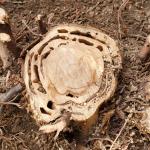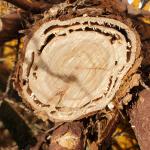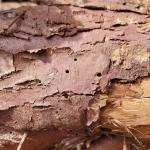The Japanese cedar longhorned beetle was first detected in Washington state in 1954. This wood boring beetle is found in conifers belonging to the cypress family. Primary hosts noted for this species include arborvitae, cypress, juniper, and cedar (Chamaecyparis). Adult beetles are small, approximately ¼ to ½ inch in length with long antennae (males have antennae that are slightly longer than their bodies; females have shorter antennae). The females have reddish brown elytra (hardened wings) and the males appear darker in color (shiny blue-black) with red visible on the “shoulders” of the beetle (just behind the thorax). There is one generation per year, although in colder locations it may take 2 years to complete its life cycle. Once the females emerge from their host, they begin to lay eggs in the cracks and crevices of bark during their 20 day life span. Each female lays approximately 20 eggs (Shibata, 1994). Eggs hatch within 2 weeks and the larvae bore beneath the bark, creating tunnels or galleries as they feed in the phloem and cambium layers of the tree or shrub. Larvae are cream colored with 3 pairs of thoracic legs and grow up to approximately ¾ inch in length. As many as 10 larvae may be found in a single arborvitae branch. When the larvae are mature, they enter the xylem where they pupate, which is suspected to occur in the fall. The Japanese cedar longhorned beetle is thought to overwinter as an adult within the host plant, and emerges early the next season in the spring (Hoebeke, 1999; Humphreys and Allen, 2000; Maier and Lemmon, 2000). However, depending upon geographic location, there is discrepancy between sources regarding the overwintering life stage of this insect. Can be confused with the native Semanotus ligneus, cedar tree borer.
The feeding damage from the larvae of this insect causes branch dieback which may not be noticed until the following spring after initial infestation. Other signs of this insect include frass found near galleries and splits in the bark and 1/8 inch, oval exit holes. Bark may appear puckered where larval mining occurs, and frass can be seen within the mines if they are exposed by splits in the bark. Frass-packed galleries occur in the cambium and xylem.
Monitor for this insect, especially in Suffolk and Nantucket Counties in Massachusetts. May also be present elsewhere in the state. Look for branch dieback on susceptible hosts in the spring. Look for bark splits, galleries, frass, and oval exit holes. With caution and the proper tools, slice open dying branches to look for galleries in the cambium and xylem and also potentially expose larvae, pupae, or adult beetles.
Borers may be preferentially attracted to stressed plants. Take precautions to avoid plant stress, such as proper planting and site selection. Prune out and destroy infested branches prior to adult emergence in the spring.
In Japan, Shibata (1994) determined that approximately 53% of pre-adult Japanese cedar longhorned beetles succumb to disease or parasitism by a suite of natural enemies. Most of the larval mortality occurs due to (as of yet) unidentified diseases; some pupal mortality occurs due to disease as well. Before pupation, larvae are also killed by two important parasitoids - Doryctes yogoi and Ischnoceros sapporensis. Two species of parasitoids from the pupal cells of Japanese cedar longhorned beetles are also known - Baeacis semanoti and Rhimphoctona spp. (Invasive Species Compendium; CABI).
Acephate (NL)
Acetamiprid (L)
Azadirachtin (NL)
Beauveria bassiana (NL)
Chlorpyrifos (N)
Cyantraniliprole (NL)
Dinotefuran (NL)
Emamectin benzoate (L)
Flonicamid+cyclaniliprole (N)
Imidacloprid (L)
Isaria (paecilomyces) fumosoroseus (NL)
Permethrin (L)
Pyrethrins + piperonyl butoxide (L)
Zeta-cypermethrin (L)
Active ingredients that may be applied systemically include: Acetamiprid (injection), cyantraniliprole (soil drench, soil injection), and imidacloprid (soil drench).
When used in a nursery setting, chlorpyrifos is for quarantine use only.
Make insecticide applications after bloom to protect pollinators. Applications at times of the day and temperatures when pollinators are less likely to be active can also reduce the risk of impacting their populations.
Note: Beginning July 1, 2022, neonicotinoid insecticides are classified as state restricted use for use on tree and shrub insect pests in Massachusetts. For more information, visit the MA Department of Agricultural Resources Pesticide Program.



